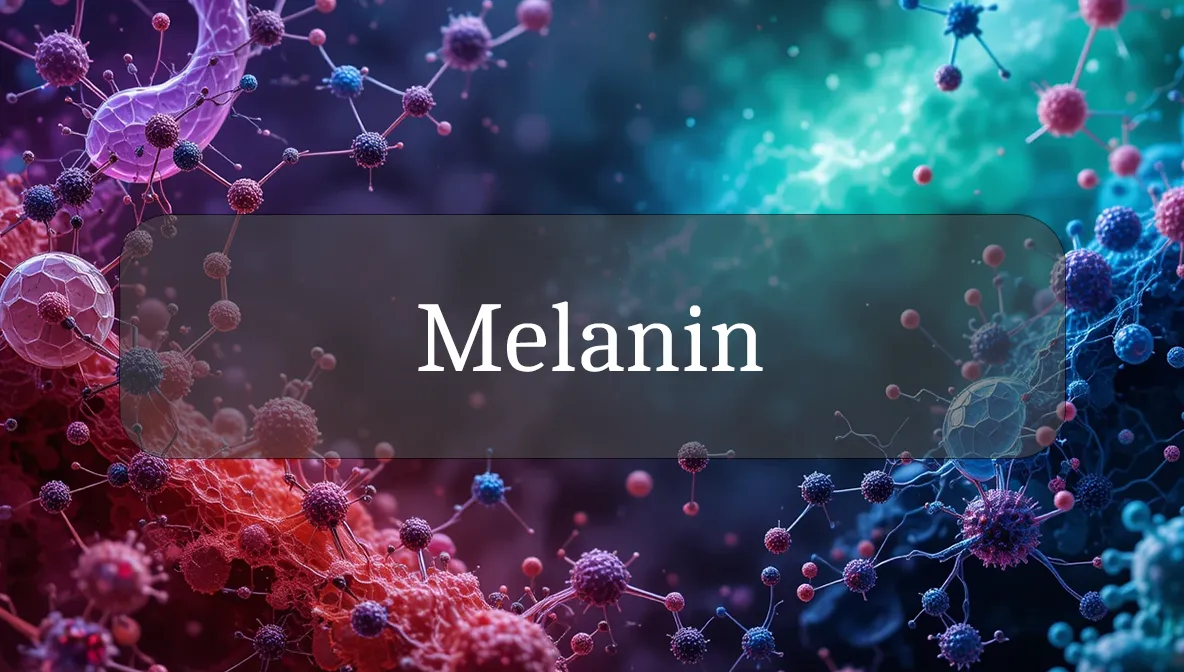Protective Pigment for Skin, Hair, and Eye Health
Melanin is like your body’s natural sunscreen, a pigment that colors your skin, hair, and eyes while shielding them from harm. Produced by specialized cells, it’s a key player for health-conscious folks aiming to maintain radiant skin and overall vitality. Understanding melanin can empower you to make choices that support your skin’s resilience and wellness. Let’s explore what melanin is, why it matters, and how you can nurture its function for daily vitality!
Chemical Identity and Type
Melanin is a group of natural pigments, primarily polymers of tyrosine-derived compounds, produced by melanocytes in the skin, hair follicles, eyes, and brain. The two main types are eumelanin (brown-black) and pheomelanin (red-yellow). Melanin absorbs UV light and neutralizes free radicals, acting as a protective shield. Think of it as your body’s built-in umbrella, guarding tissues against environmental damage.
Biological Role and Benefits
Melanin is a cornerstone of your skin, hair, and eye health, offering these benefits:
- UV Protection: It absorbs harmful UV rays, reducing skin damage, sunburn, and skin cancer risk.
- Skin Health: Melanin maintains skin tone and protects against premature aging caused by sun exposure.
- Eye Protection: In the iris and retina, it shields eyes from UV light, supporting vision and reducing glare.
- Hair Color and Strength: Melanin gives hair its color and protects follicles from oxidative stress, enhancing resilience.
- Antioxidant Defense: It neutralizes free radicals, protecting cells from damage and supporting overall health.
Healthy melanin levels keep your skin radiant, eyes protected, and hair vibrant, enhancing overall vitality.
Dietary or Natural Sources
Your body produces melanin naturally, relying on tyrosine and other nutrients. You don’t get melanin directly from food, but you can support its production with these nutrient-rich choices:
- Tyrosine-Rich Foods: Eggs, turkey, fish, and soy provide tyrosine, the amino acid precursor for melanin.
- Antioxidant-Rich Foods: Berries, leafy greens, and citrus fruits (high in vitamin C) protect melanocytes from oxidative stress.
- Copper-Rich Foods: Shellfish, nuts, and dark chocolate support tyrosinase, an enzyme critical for melanin synthesis.
- Vitamin E-Rich Foods: Almonds, sunflower seeds, and avocados shield skin from UV damage, complementing melanin’s role.
A balanced diet with these nutrients supports melanin production and skin health.
Signs of Imbalance or Dysfunction
Melanin imbalances or dysfunction (due to genetics, aging, or environmental factors) may show up as:
- Hypopigmentation: Light patches or loss of color (e.g., vitiligo, albinism), increasing UV sensitivity.
- Hyperpigmentation: Dark spots, melasma, or uneven skin tone from excess melanin production.
- Skin Sensitivity: Increased sunburn or irritation in low-melanin skin, indicating reduced UV protection.
- Hair Graying: Early graying or loss of hair color due to declining melanin in follicles.
- Eye Issues: Light sensitivity or vision problems in cases of low ocular melanin (e.g., albinism).
These symptoms can have many causes, so if they persist, consult a healthcare provider to explore skin or melanin-related issues.
Supporting Optimal Levels or Function
To enhance melanin production and protect its function, try these evidence-based tips:
- Eat Nutrient-Dense Foods: Include eggs, berries, or nuts to provide tyrosine and antioxidants for melanin synthesis.
- Protect Skin: Use broad-spectrum sunscreen (SPF 30+), wear protective clothing, and limit sun exposure to prevent melanin overproduction or damage.
- Stay Hydrated: Drink water to keep skin moist, supporting its barrier alongside melanin’s protective role.
- Exercise Moderately: Activities like walking or yoga improve blood flow, delivering nutrients to melanocytes.
- Avoid Smoking: Quit smoking to prevent oxidative stress, which can impair melanin production and skin health.
Small, consistent habits create a melanin-friendly environment for radiant, protected tissues.
Safety, Interactions, and Precautions
Melanin is a natural pigment and safe when balanced, but consider these factors:
- Skin Conditions: Disorders like vitiligo or melasma involve melanin dysregulation and may require dermatological care.
- Supplements: No direct melanin supplements exist, but tyrosine or vitamin C supplements may support skin health. Consult a healthcare provider before use.
- Medications: Some drugs (e.g., hydroquinone for hyperpigmentation) affect melanin production and may cause side effects like skin irritation. Discuss with your doctor.
- UV Exposure: Excessive sun exposure can trigger melanin overproduction, leading to dark spots or increased skin cancer risk, especially in lighter skin.
Protecting melanin balance means safeguarding skin health and managing UV exposure.
Fun Fact
Did you know melanin is so powerful it can absorb nearly all UV light? That’s why darker skin tones have a natural SPF of about 13, offering built-in protection against the sun’s rays!
Citations
- National Institutes of Health (NIH): Melanin and Skin Protection.
- Mayo Clinic: Skin Pigmentation Disorders.
- Cleveland Clinic: Nutrition and Skin Wellness.
- World Health Organization (WHO): Diet and UV Protection Guidelines.
- USDA: Dietary Guidelines for Americans – Nutrient-Dense Diets.

